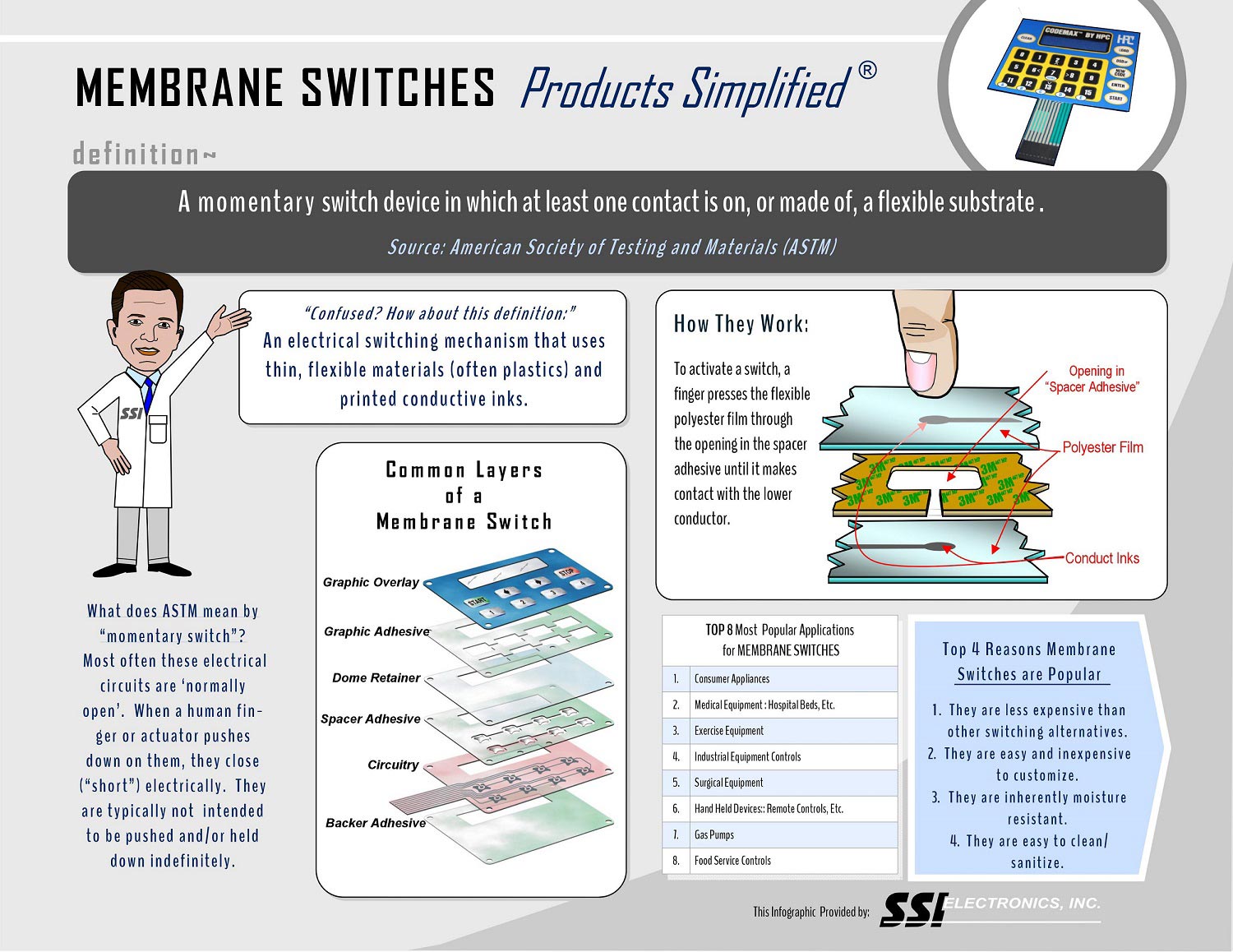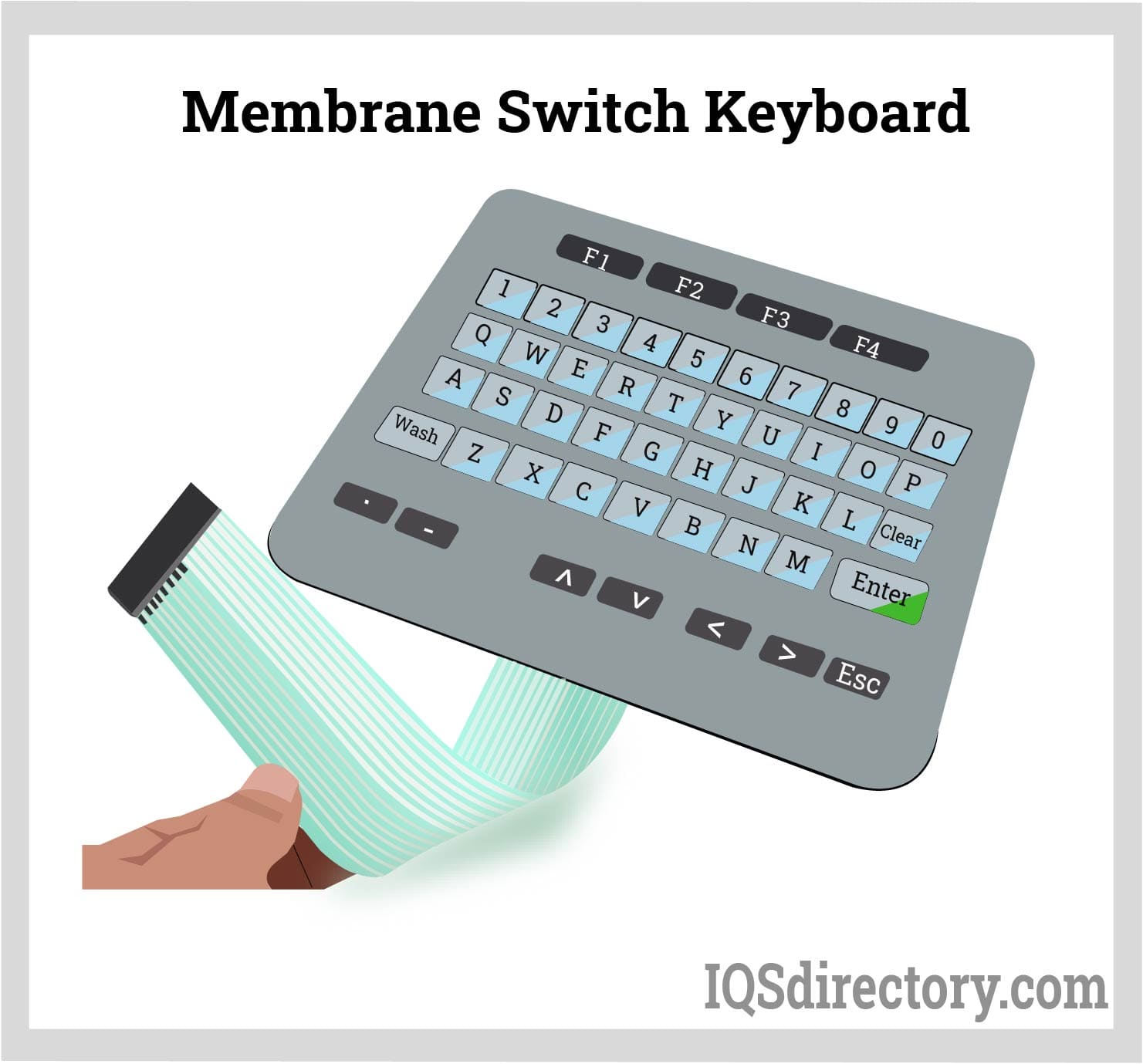Understanding the Relevance of Membrane Layer Change in Modern Electronics
Membrane buttons are indispensable elements in modern digital tools. They supply a blend of performance and layout that improves individual interaction. Their lightweight and resilient nature makes them suitable for numerous applications. As industries develop, the demand for customization and advanced functions expands. Recognizing just how membrane layer changes add to advancement discloses their significance fit the future of electronics. What exists ahead for this innovation?
The Basics of Membrane Switch Over Innovation
Although usually overlooked, membrane layer switch technology plays a necessary duty in the modern electronic devices landscape - membrane switch. These tools, composed of numerous layers, act as individual interfaces for numerous electronic products, varying from household home appliances to clinical tools. A common membrane layer button contains a graphic overlay, a spacer layer, and a circuit layer, which are thoroughly assembled to produce a useful interface.When pressure is related to the overlay, the circuit layer is completed, enabling signals to be sent to the tool. This technology is known for its adaptability, making it possible for personalization in capability, layout, and form to fulfill details user requirements. Additionally, membrane buttons are slim and lightweight, making them appropriate for applications where area is a premium. Their toughness and resistance to ecological variables better boost their allure, guaranteeing they can hold up against severe problems while preserving performance. On the whole, membrane switch technology is essential to creating efficient and user-friendly digital gadgets

Secret Advantages of Membrane Layer Changes
Membrane switches over offer several vital advantages that make them a preferred selection in different digital applications. Their style allows for a portable type factor, making it possible for producers to produce sleek and light-weight gadgets. Additionally, membrane layer switches are resistant to dirt, wetness, and chemicals, which enhances their toughness and longevity in requiring environments. The responsive feedback supplied by these switches can boost user experience, making them easy and instinctive to operate.Furthermore, membrane switches can be tailored with diverse graphics and colors, permitting for distinct branding opportunities. The manufacturing procedure is typically cost-efficient, particularly for high-volume manufacturing, as it reduces assembly time and streamlines layout. Membrane layer switches require very little upkeep, adding to lower overall operational expenses. These benefits emphasize their expanding popularity in contemporary electronic devices, where integrity and easy to use user interfaces are necessary.

Applications Across Numerous Industries
The adaptability of membrane switches over enables their prevalent fostering across different industries. In the clinical field, they are frequently utilized in analysis devices and client surveillance systems, using a resilient user interface immune to pollutants. The vehicle sector utilizes membrane layer switches for control panel controls, enhancing customer experience with smooth styles that withstand extreme problems. In consumer electronics, they serve as control board for gadgets such as microwaves and coffee makers, giving an easy to use user interface that is very easy to clean. The aerospace field uses membrane layer buttons in cabin controls, where integrity and space performance are paramount. In addition, the industrial market leverages these switches in equipment and control systems to assure durable operation in requiring environments. This wide array of applications highlights the flexibility of membrane layer buttons, making them important components in boosting performance and customer communication across varied technological landscapes.
Personalization and Design Versatility

Future Fads in Membrane Layer Switch Over Growth
Arising patterns in membrane switch development show an expanding focus on improved functionality and integration with smart technologies. As customer need for a lot more advanced electronic tools rises, makers are concentrating on producing membrane switches over that not just serve basic functional functions however also include attributes like touch level of sensitivity, backlighting, and haptic feedback.Furthermore, improvements in materials are anticipated to enhance sturdiness and environmental resistance, making membrane layer switches over suitable for varied applications in markets such as healthcare, auto, and consumer electronics. The combination of capacitive touch technology is most likely to end up being more widespread, enabling for sleeker styles and enhanced user interfaces. membrane switch.Additionally, the increase of the Internet of Points (IoT) is prompting the growth of membrane switches over that can interact wirelessly with various other devices, boosting interconnectivity. In general, the future of membrane layer switch modern technology appears encouraging, driven by development and the search of easy to use remedies
Regularly Asked Concerns
Just How Do Membrane Changes Contrast to Conventional Mechanical Buttons?
Membrane layer switches, being extra space-efficient and providing a smooth layout, contrast with conventional mechanical buttons that provide responsive responses. The former commonly feature adjustable graphics, while the last typically ensure longevity and reliability in different applications.
What Products Are Generally Used in Membrane Change Manufacturing?
Membrane layer switches are usually generated making use of materials such as polyester, polycarbonate, and printed conductive inks. These materials offer adaptability, longevity, and responsiveness, making them suitable for numerous applications in electronic gadgets and interface.
Can Membrane Layer Switches Over Be Fixed or Reused?
Membrane switches can frequently be repaired, specifically if small problems occur, such as adhesive failing or surface area damage. However, complete reuse is commonly restricted because of wear and possible deterioration of products in time.
Just How Do Environmental Aspects Affect Membrane Layer Switch Efficiency?
Environmental variables, such as temperature level, exposure, and humidity to chemicals, significantly influence membrane button performance. Severe conditions can lead to degradation, affecting responsiveness and long life, eventually jeopardizing the performance of the device in various applications.
What Is the Typical Lifespan of a Membrane Layer Change?
The normal life expectancy of a membrane layer button normally varies from 1 to 5 million actuations, relying on variables such as use frequency, ecological conditions, and the materials utilized in manufacturing, affecting sturdiness and performance durability. A normal membrane layer button is composed of a visuals overlay, a spacer layer, and a circuit layer, which are meticulously constructed to their explanation produce a functional interface - membrane switch.When pressure is applied to the overlay, the circuit layer is finished, enabling signals to be sent to the gadget. The responsive comments offered by these buttons can enhance customer experience, making them user-friendly and easy to operate.Furthermore, membrane switches can be customized with diverse graphics and shades, enabling for special branding opportunities. As customer demand for a lot more innovative electronic tools boosts, producers are focusing on developing membrane changes that not only offer fundamental operational roles however also blog incorporate functions like touch sensitivity, backlighting, and haptic feedback.Furthermore, improvements in products are expected to boost sturdiness and environmental resistance, making membrane switches appropriate for varied applications in markets such as health care, auto, and customer electronics. The combination of capacitive touch modern technology is likely to end up being much more common, permitting for sleeker layouts and boosted user interfaces.Additionally, the increase of the Internet of Things (IoT) is triggering the growth of membrane changes that can connect wirelessly with other tools, enhancing interconnectivity. Membrane layer switches, being extra space-efficient and offering a sleek layout, comparison with traditional mechanical buttons that give responsive responses